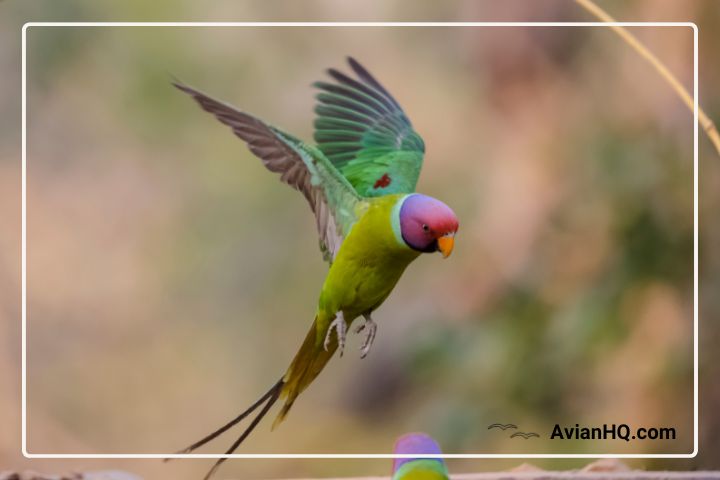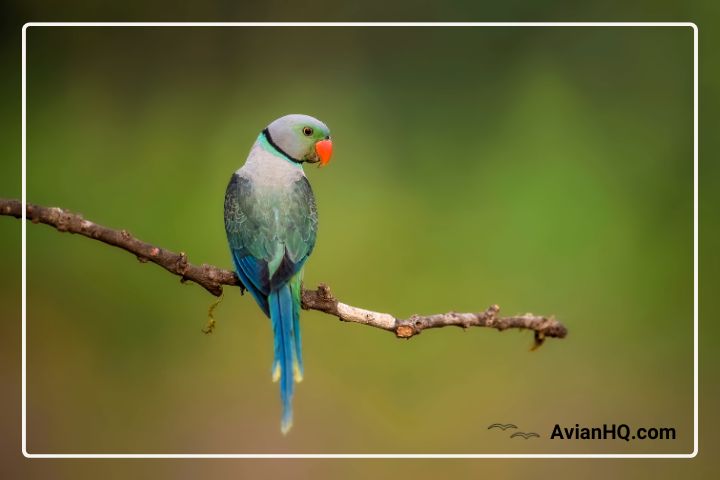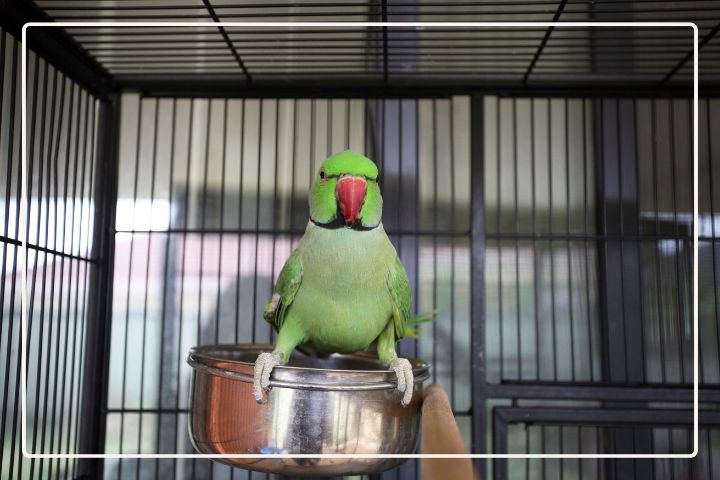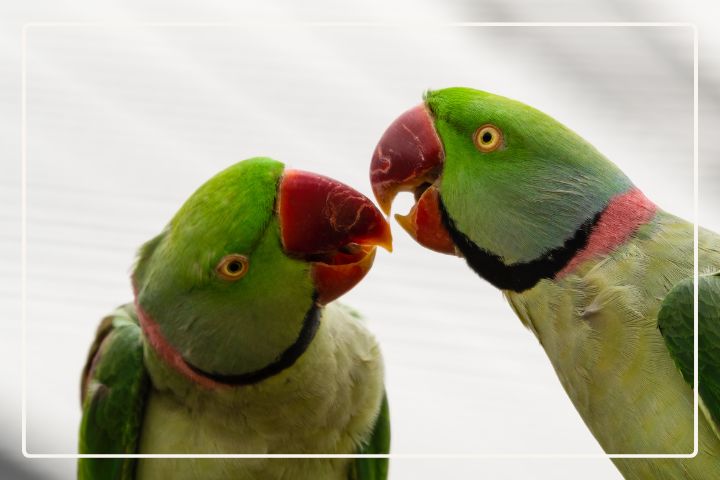Plum Headed Parakeet: Overview, Characteristics and Care
The Plum Headed Parakeet (scientific name Psittacula cyanocephala), also known as the Plum Headed Parrot, is a colorful and intelligent bird species that belongs to the parrot family. They are native to the Indian subcontinent and can be found in many areas in India, Pakistan, Nepal, Sri Lanka and Bangladesh.
They have a playful and curious nature and can develop a strong bond with their human companions and are popular among bird enthusiasts as pets.
In this article, you will learn about the unique characteristics, behavior, habitat, diet, and care requirements of the Plum-Headed Parakeet. You will also discover why they make great pets and how to provide proper care to ensure their health and happiness.
Key Takeaways:
- The Plum Headed Parakeet is a colorful and intelligent bird species that belongs to the parrot family.
- They have a distinctive plumage of vibrant green, blue, purple, and yellow.
- Plum Headed Parakeets are popular among bird enthusiasts as pets due to their playful and curious nature and ability to form strong bonds with their human companions.
- In this article, you will learn about their behavior, habitat, diet, and care requirements, as well as how to provide proper care to ensure their health and happiness.
Plum Headed Parakeet Habitat
The Plum Headed Parakeet is native to the Indian Subcontinent and can be found in a variety of habitats, including tropical and subtropical forested areas, open woodland, and cultivated land. They are also known to frequent gardens and parks in urban areas.
These birds are typically found in areas with a warm climate, where temperatures range between 68°F and 86°F. They prefer to live in areas with plenty of vegetation, such as trees for roosting and nesting. The Plum Headed Parakeet also requires access to water sources, such as lakes, ponds, or streams.
In captivity, it is important to provide a similar habitat to their natural environment. A large cage or aviary with plenty of perches and toys to play with, as well as access to fresh water and a balanced diet, will keep your Plum Headed Parakeet healthy and happy.
Plum Headed Parakeet Appearance
The Plum-Headed Parakeet is a relatively small to medium sized parakeet species. Their total length ranges from 12-14 inches (30-36 cm), with a decent portion of that being the tail at 4-6 inches (10-15 cm) long. Their body length is around 5-6 inches (13-15 cm), single wingspan 7 inches (18 cm), and weight very light at 1.5-2 ounces (40-60 grams). The bright plumage and coloration is packed into a petite package with these charming parakeets.
Plum-Headed Parakeets are known for their distinctive plumage, which is a combination of vibrant green, blue, purple, and yellow. Their vibrant green feathers are contrasted with a deep purple-blue head and neck. The males have a colorful red beak, while the females have a gray beak. Plum Headed Parakeets also have distinctive black stripes on their chin and cheeks, adding to their unique appearance.
The Plum-Headed Parakeet’s wings and back are a bright grass green color. The upper tail feathers are also green with some yellow and blue mixed in. The throat and breast area transitions from the purple-blue neck to a pale yellow-green. The lower belly and undertail feathers are more yellow in color. From head to tail, these parakeets are an explosion of lively hues.
The plumage of the Plum-Headed Parakeet serves multiple purposes. The bright coloration helps these social birds recognize others of their kind. The green color of their back and wings helps provide camouflage when perched among foliage. And the unique patterning of the head may help identify individuals within a flock. Overall, the Plum-Headed Parakeet’s vibrant and distinctive plumage aids in socialization, camouflage, and mate identification.
Plum Headed Parakeet Behavior
The Plum Headed Parakeet is known for its charming and playful nature, making it a popular choice for pet owners. These birds are social creatures, often found in flocks in their natural habitat. They are curious and energetic, always exploring their surroundings.
Communication is an important aspect of Plum Headed Parakeet behavior. They use a variety of sounds and body language to convey messages to their flock mates. Their vocalizations range from chirping and whistling to loud screeches and squawks.
One notable behavior of these birds is their ability to mimic sounds. With proper training, they can learn to imitate human speech, music, and other sounds in their environment. This makes them a fascinating pet to watch and interact with.
The Plum Headed Parakeet also has a strong bond with its human companion. They thrive on regular interaction and attention, making them a great choice for someone who has the time and patience to give them the socialization they need.
It’s important for pet owners to understand that Plum Headed Parakeets can have aggressive tendencies if they feel threatened or stressed. Providing a calm and safe environment, along with proper training and socialization, can help prevent these behaviors.
Daily Rhythms of the Plum Headed Parakeet
Plum headed parakeets follow predictable daily routines of feeding, resting, preening, vocalizing, and socializing. In their native habitats, they tend to be most active during the early morning and late afternoon hours.
Shortly after sunrise, flocks will leave their roosting sites to forage for their breakfast. They busy themselves searching for and consuming various fruits, seeds, nectar, buds, and the occasional insect. After this initial burst of feeding activity, the parakeets find shady spots to rest and preen their feathers. They are less vocal and active during the hottest midday hours.
As the day cools down in late afternoon, another burst of activity ensues. More frantic feeding prepares the parakeets for nightfall. They socialize in small flocks, preening each other and squawking back and forth. This is an important time for pair bonding and interactions between flock mates.
Close to dusk, the parakeets become quieter and more subdued as they settle back into their chosen roosting cavity for the night. Soft chirping can be heard as the flock settles in for sleep. Their active period will begin again the next morning.
In captivity, Plum headed parakeets can maintain normal circadian rhythms if their enclosure mimics the natural light and dark cycle. Adjusting artificial lighting to match sunrise and sunset helps them maintain their natural patterns of wakefulness and rest.
Plum Headed Parakeet Diet
The Plum Headed Parakeet is an omnivorous bird that feeds on a variety of foods in the wild. Their diet mainly consists of fruits, seeds, buds, nectar, insects, and small invertebrates.
In captivity, they require a balanced diet that mimics their natural feeding habits. A commercial parakeet seed mix forms the basis of their diet, but it should be supplemented with fresh fruits and vegetables. The diet should include a variety of fresh fruits and vegetables, such as apples, pears, grapes, berries, carrots, broccoli, and leafy greens.
It is advisable to avoid high-fat and high-sugar foods like chocolate, avocado, and junk food, as these can cause health issues in parakeets. Their diet should also include sources of protein, such as cooked eggs, boiled chicken, and mealworms. Fresh water should be provided daily, and the water bowl should be cleaned regularly.
It is essential to monitor the Plum Headed Parakeet’s diet to ensure they are getting all the necessary nutrients. A parakeet’s diet requires a balance of carbohydrates, proteins, fats, vitamins, minerals, and water.
Plum Headed Parakeet Care
If you are considering keeping a Plum Headed Parakeet as a pet, it’s important to understand their care requirements to ensure the bird’s health and happiness.
Housing:
The Plum Headed Parakeet requires a spacious cage that allows them to move around freely. The recommended minimum size for one bird is 36″ L x 24″ W x 36″ H inches, with the bar spacing not exceeding 0.5 inches. The cage must have enough perches, toys, and hiding places to keep the bird entertained and mentally stimulated. Place the cage in a draft-free area, away from direct sunlight, and maintain a comfortable temperature.
Grooming:
Regular grooming is essential to keep the Plum Headed Parakeet healthy. Trim their nails every six to eight weeks and check their beak for overgrowth. Provide them with fresh water for bathing and mist them occasionally to keep their feathers in good condition.
Diet:
The Plum Headed Parakeet feeds on a variety of fruits, vegetables, seeds, and pellets. Their diet should be balanced and contain essential nutrients, including calcium, protein, and vitamins. Offer fresh food daily and remove any uneaten portions to prevent spoilage.
Health:
Keep a close eye on your Plum Headed Parakeet’s behavior and physical appearance to detect any signs of illness. Common health issues include respiratory infections, feather plucking, and psittacosis. Schedule regular check-ups with an avian veterinarian and provide the bird with plenty of opportunities for exercise and mental stimulation.
Training:
The Plum Headed Parakeet is an intelligent bird that can be trained to perform tricks, mimic sounds, and even talk. Positive reinforcement, patience, and consistency are key to successful training. Socialize the bird early on and provide them with plenty of attention and interaction to strengthen the bond with their human companions.
By following these tips, you can provide your Plum Headed Parakeet with a happy and healthy life as a pet.
Plum Headed Parakeet Breeding
The Plum Headed Parakeet is known to breed readily in captivity. However, before deciding to breed them, it is essential to ensure you have the appropriate housing, diet, and other conditions necessary for breeding success. Furthermore, it is best to wait until the bird has reached sexual maturity, which is typically between 1-2 years of age.
Reproductive Cycle
The breeding season for Plum Headed Parakeets typically occurs between April and June, as these birds prefer warmer temperatures for breeding. During this time, male birds become more vocal, and their cere (the area above the beak) changes color to a more intense shade of blue. They also become more territorial and protective of their nesting site.
Females lay an average of 3-4 eggs, which hatch within 23-24 days. The chicks are born altricial, meaning they are born without feathers and require intensive care from their parents. For the first few weeks of life, the chicks are entirely dependent on their parents for warmth, food, and protection.
Nesting Behavior
In the wild, Plum Headed Parakeets nest in tree hollows, making a rough nest of wood chips and leaves. In captivity, they will readily accept a nesting box or a hollow log with a small entrance hole. Providing nesting materials, such as wood shavings or leaves, can encourage the birds to start their nest. It is essential to provide a comfortable and secure nesting area, as the eggs and chicks are vulnerable to injury if the nesting material is inadequate or the nesting area is disturbed.
Successful Breeding in Captivity
Successful breeding of Plum Headed Parakeets in captivity requires providing the right environment and diet. Closely monitor your birds to ensure they are healthy, happy, and have everything they need to thrive. Providing a balanced diet rich in fresh fruits, vegetables, and grains can help increase the chances of successful breeding.
It is also important to take measures to prevent stress, as it can interfere with breeding success. This includes providing ample space for the birds to fly, play, and exercise, as well as maintaining a consistent day/night cycle and keeping the birds in a quiet, low-traffic area.
Finding an Ethical Source for a Pet Parakeet
The plum headed parakeet has long been a popular pet bird. However, it is important to obtain captive bred parakeets from reputable and ethical sources. Removing parakeets from the wild to sell as pets can negatively impact wild populations.
Responsible breeders focus on captive parakeet bloodlines. They work to maintain genetic diversity and do not take birds from the wild. Reputable breeders also follow protocols to quarantine, health test, and properly socialize baby parakeets before placement.
Rescue organizations are another excellent option. Many take in unwanted pet parakeets that need new homes. Adopting from a parakeet rescue helps provide a second chance for a bird in need. Just be sure the organization does not also collect wild parakeets.
Local parakeet interest groups or clubs may have resources to help you find captive bred birds available in your area. Connecting with experienced parakeet owners provides valuable guidance in your search for an ethical breeder or rescue organization.
Patience may be required to obtain a pet plum headed parakeet from an ethical source. But protecting wild populations and supporting conscientious breeders ultimately benefits the species and the parakeet community. Doing your research will help ensure a beloved pet with a responsible background.
Plum Headed Parakeet as a Pet
The Plum Headed Parakeets are friendly, playful, and intelligent birds that can form strong bonds with their owners. Here is some essential information to ensure you provide the best possible care for your Plum Headed Parakeet.
Trainable Nature
One of the most enjoyable aspects of owning a Plum Headed Parakeet is their trainable nature. They are quick learners and can be taught to perform a range of tricks. Start with simple commands and gradually increase the difficulty level. Always use positive reinforcement techniques like treats and praise to encourage good behavior.
Vocalization and Mimicry
Plum Headed Parakeets are known for their remarkable ability to mimic sounds and human speech. They are excellent communicators and often use vocalizations to express their emotions and interact with their owners. Encourage your parakeet to talk by repeating words and phrases regularly and rewarding them with treats and attention when they respond.
Housing Requirements
The Plum Headed Parakeet needs a spacious and comfortable living space to thrive. A large cage with plenty of room to move around is essential. Provide perches of varying sizes and materials to help maintain their foot health. Make sure the cage is placed in a location that is well-lit and free from drafts.
Grooming Needs
Regular grooming is essential for the health and well-being of your Plum Headed Parakeet. Trim their wings, nails, and beak regularly to keep them in good condition. Provide your parakeet with a shallow dish of water for bathing. It is crucial to keep their living space clean and hygienic to prevent infections and diseases.
Health Issues
Plum Headed Parakeets are relatively hardy birds, but they are susceptible to certain health issues like feather picking, respiratory infections, and egg-binding. Always keep an eye out for signs of illness like lethargy, loss of appetite, and unusual behavior. Regular visits to an avian veterinarian are essential to maintain your pet’s health.
Conservation Status of the Plum Headed Parakeet
In the wild, the plum headed parakeet has a wide distribution but is considered to be a species of least concern by the International Union for Conservation of Nature (IUCN). However, in some areas their numbers have declined from habitat loss and capture for the pet trade.
The global population is estimated to be between 100,000 – 1 million individuals. Their wide geographic range across the Indian subcontinent lends them some protection. However, plum headed parakeets face threats from deforestation, urbanization, and agricultural expansion reducing their natural habitat.
This species is listed on Appendix II of CITES, which regulates their trade. Trapping wild parakeets for the pet industry occurred in the past, but has declined significantly. While the overall wild population remains steady, local declines have been observed in Nepal, Pakistan, and India.
Several reserves and protected areas have been established that provide sanctuary for wild populations of plum headed parakeets. Continued protection of their natural habitat will be needed to ensure this species does not become threatened in the future. Conscientious captive breeding programs also help reduce pressure on wild populations.
With sustained conservation efforts, the outlook for plum headed parakeets remains optimistic. This adaptable parrot has a stable total population, but monitoring is needed to prevent future habitat loss from becoming a danger. Careful regulation of trapping and the pet trade remains prudent to protect local populations.
Conclusion
The Plum Headed Parakeet is a fascinating parrot species that has captured the hearts of many bird enthusiasts. As outlined in this article, they are known for their unique characteristics such as their colorful plumage, social behavior, and ability to mimic sounds.
Proper care is essential for keeping a Plum Headed Parakeet healthy and happy. This includes providing a well-balanced diet, a spacious and safe living environment, and regular grooming.
For those interested in owning a Plum Headed Parakeet as a pet, it is important to remember that they require social interaction and mental stimulation. With proper attention and training, they can become beloved companions.
The Plum Headed Parakeet is a wonderful addition to any bird lover’s collection. With their beautiful appearance and engaging personality, they are sure to bring joy to any home.
FAQ
Q: What is the average lifespan of a Plum Headed Parakeet?
A: Plum Headed Parakeets have an average lifespan of 15 to 20 years when provided with proper care and a balanced diet.
Q: Can Plum Headed Parakeets talk?
A: While they are not known for their talking abilities like some other parrot species, Plum Headed Parakeets can learn to mimic a few simple words and sounds.
Q: Do Plum Headed Parakeets require a specific type of enclosure?
A: Yes, Plum Headed Parakeets need a spacious cage with plenty of room for flying and playing. It should also be equipped with perches, toys, and a separate feeding area.
Q: Are Plum Headed Parakeets good with children?
A: Plum Headed Parakeets can be great companions for children, but they require proper supervision to ensure the safety of both the bird and the child. Teaching children to handle them gently is important.
Q: How often should I clean my Plum Headed Parakeet’s cage?
A: It is recommended to clean the cage of a Plum Headed Parakeet at least once a week, but spot cleaning should be done regularly to maintain a clean and hygienic environment.
Q: Can Plum Headed Parakeets live alone or do they need a companion?
A: Plum Headed Parakeets are social birds and thrive in the company of their own kind and are happiest when kept in pairs or small groups.
Q: What should I feed my Plum Headed Parakeet?
A: A balanced diet for Plum Headed Parakeets includes a variety of fresh fruits and vegetables, high-quality parrot pellets, and a limited amount of seeds. Consult with a veterinarian for specific dietary recommendations.
Q: How often should I take my Plum Headed Parakeet to the veterinarian?
A: Regular veterinary check-ups are important to ensure the health and well-being of your Plum Headed Parakeet. An annual visit to a qualified avian veterinarian is recommended.
Q: Can Plum Headed Parakeets be trained to do tricks?
A: Yes, Plum Headed Parakeets are intelligent and can be trained to perform simple tricks and commands using positive reinforcement techniques.
Q: Are Plum Headed Parakeets noisy?
A: Plum Headed Parakeets have a moderate noise level compared to other parrot species and can make chirping and squawking sounds, especially during play and social interactions.








Would love to perpetually get updated great website! .